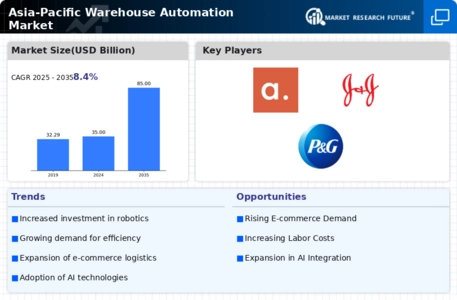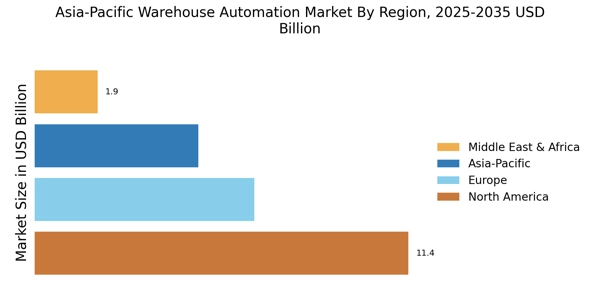Rising E-Commerce Demand
The surge in e-commerce activities across the Asia-Pacific region is a primary driver for the Asia-Pacific Warehouse Automation Market. As consumers increasingly prefer online shopping, businesses are compelled to enhance their logistics and supply chain operations. This shift necessitates the implementation of automated systems to manage inventory efficiently and fulfill orders promptly. According to recent estimates, the e-commerce sector in Asia-Pacific is projected to grow at a compound annual growth rate of over 20% in the coming years. Consequently, companies are investing in warehouse automation technologies to streamline operations, reduce labor costs, and improve order accuracy, thereby positioning themselves competitively in the market.
Technological Advancements
Rapid advancements in technology are significantly influencing the Asia-Pacific Warehouse Automation Market. Innovations such as artificial intelligence, machine learning, and the Internet of Things are transforming traditional warehouse operations. These technologies enable real-time data analysis, predictive maintenance, and enhanced inventory management, which are crucial for optimizing supply chain efficiency. The integration of automated guided vehicles and robotic systems is also on the rise, facilitating faster and more accurate order fulfillment. As companies increasingly recognize the potential of these technologies, investments in warehouse automation are expected to escalate, thereby driving market growth in the region.
Focus on Supply Chain Resilience
The emphasis on building resilient supply chains is a critical driver for the Asia-Pacific Warehouse Automation Market. Recent disruptions in global supply chains have highlighted the need for businesses to adopt more flexible and responsive logistics solutions. Automation technologies provide the agility required to adapt to changing market conditions and consumer demands. By implementing automated systems, companies can enhance their operational resilience, reduce lead times, and improve overall supply chain visibility. This strategic focus on resilience is likely to propel investments in warehouse automation, as organizations seek to future-proof their operations against unforeseen challenges.
Labor Shortages and Rising Costs
Labor shortages in the Asia-Pacific region are becoming increasingly pronounced, prompting companies to seek automation solutions within the Asia-Pacific Warehouse Automation Market. The rising costs associated with hiring and retaining skilled labor are compelling organizations to invest in automated systems that can perform repetitive tasks with greater efficiency. Reports indicate that labor costs in logistics have risen significantly, leading to a reevaluation of operational strategies. Automation not only mitigates the impact of labor shortages but also enhances productivity and reduces operational risks. As a result, businesses are likely to prioritize investments in warehouse automation technologies to maintain competitiveness and ensure operational continuity.
Government Initiatives and Support
Government initiatives aimed at promoting technological innovation and industrial automation are playing a pivotal role in the Asia-Pacific Warehouse Automation Market. Various governments in the region are implementing policies and providing incentives to encourage businesses to adopt automation technologies. These initiatives often include funding for research and development, tax breaks, and support for training programs to upskill the workforce. As a result, companies are more inclined to invest in warehouse automation solutions, knowing that they have governmental backing. This supportive environment is expected to foster growth in the warehouse automation sector, as businesses leverage these opportunities to enhance their operational capabilities.

















Leave a Comment